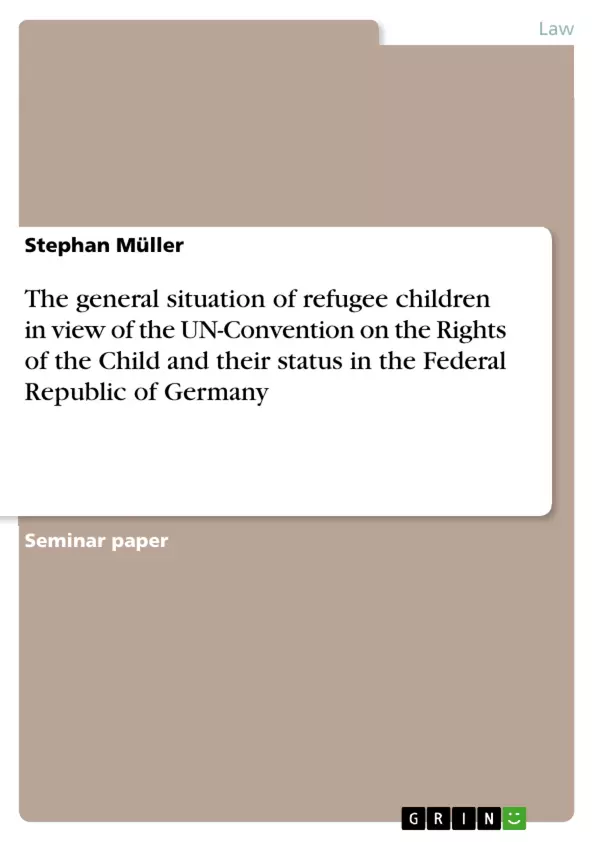Refugee children suffer from war or other forms of persecution in their countries of origin, many even continue to suffer human rights violations in the countries in which they seek asylum. Around half of the world's refugees are children, yet their rights and special supporting and protection needs as children are frequently neglected. The human rights violations that force children to flee from their homes are only a part of the hardships for many child refugees. Even after travelling across an international border to seek refuge, they remain vulnerable to hazardous labour exploitation, denial of education, physical abuse, routine detention, sexual abuse, cross-border attacks, militarization of refugee camps, and recruitment as soldiers.
The purpose of this study is to provide an overview of the circumstances of refugee children, the UN-Convention on the Rights of the Child and describe the asylum-juridical contact with refugee children in the Federal Republic of Germany and above all examine, whether and to which extent this contact is contradictory to the central concern of the UN-Convention on the Rights of the Child.
B) The circumstances of refugee children
Adolescent- and child refugees are differentiated into accompanied and unaccompanied. Accompanied are those who flee with their parents and siblings, members of their family or other important bonding figures and role models. It is assumed that currently around 100,000 unaccompanied minors exist as refugees in Europe.
Children and adolescents are the most vulnerable and in need of support and protection. When children are removed from their normal cultural, economical and social environment, it may generate serious psychological problems such as a disruption of the emotional development and a profound sense of disorientation due to loss of role models like parents and relatives.
(...)
Inhaltsverzeichnis (Table of Contents)
- A) Introduction
- B) The circumstances of refugee children
- C) The United Nations Convention on the Rights of the Child.
- D) Refugee children in the Federal Republic of Germany
- I. Countries of Origin and fleeing reasons...
- II. The National Coalition for the Implementation of the UN Convention on the Rights of the Child in Germany (NC)......
- III. Children's Rights in the view of German Federal Law...
- E) Conclusion......
Zielsetzung und Themenschwerpunkte (Objectives and Key Themes)
The main objective of this study is to provide a comprehensive overview of the circumstances faced by refugee children, analyze the UN-Convention on the Rights of the Child, and examine the asylum-juridical interaction with refugee children in the Federal Republic of Germany. The primary focus is on evaluating whether and to what extent this interaction contradicts the core principles of the UN-Convention on the Rights of the Child.
- The specific challenges and hardships faced by refugee children, including human rights violations and vulnerability to exploitation.
- The provisions and principles of the UN-Convention on the Rights of the Child and its applicability to refugee children.
- The legal framework and practices related to asylum and refugee children in Germany, including the role of the National Coalition for the Implementation of the UN Convention on the Rights of the Child in Germany (NC).
- The potential conflicts between German asylum laws and the principles enshrined in the UN-Convention on the Rights of the Child.
- The unique psychological and developmental needs of refugee children and the challenges associated with their integration into new environments.
Zusammenfassung der Kapitel (Chapter Summaries)
A) Introduction: This chapter introduces the topic of refugee children, highlighting their vulnerability and the human rights violations they face both in their home countries and as asylum seekers. The study aims to explore the challenges they encounter and the applicability of the UN-Convention on the Rights of the Child to their situation.
B) The circumstances of refugee children: This chapter differentiates between accompanied and unaccompanied refugee children, exploring the specific challenges faced by each group. It emphasizes the vulnerability of children who have been removed from their cultural, economic, and social environments, and the potential for psychological problems and cultural identity loss.
C) The United Nations Convention on the Rights of the Child: This chapter examines the international agreements on children's rights, focusing on the 1989 UN-Convention on the Rights of the Child. It discusses the evolving understanding of childhood and the rights and responsibilities of governments in ensuring the well-being of children, including refugee children.
D) Refugee children in the Federal Republic of Germany: This chapter delves into the specific situation of refugee children in Germany, examining the reasons for their migration, the role of the National Coalition for the Implementation of the UN Convention on the Rights of the Child in Germany (NC), and the legal framework for protecting children's rights within German law.
Schlüsselwörter (Keywords)
This study focuses on the intersection of international law, children's rights, and the specific challenges faced by refugee children. Key themes and concepts include the UN-Convention on the Rights of the Child, asylum-juridical interaction, vulnerability, exploitation, human rights violations, cultural identity loss, and the unique needs of refugee children.
- Citation du texte
- Stephan Müller (Auteur), 2008, The general situation of refugee children in view of the UN-Convention on the Rights of the Child and their status in the Federal Republic of Germany , Munich, GRIN Verlag, https://www.grin.com/document/115764



